
Highlights of Budapest, Vienna, Prague, Krakow & Warsaw in 15 days
 15 Day Tour of Budapest, Vienna, Prague, Krakow and Warsaw
15 Day Tour of Budapest, Vienna, Prague, Krakow and Warsaw
Overview
Trip Map
Itinerary
Inclusions
Reviews







15 Days 14 Nights
Best Time: Jan-Dec
Cultural Exploration
History Buffs
Journey through Central and Eastern Europe on this whirlwind trip, where history whispers from cobblestone streets and ancient castles. Each city on your itinerary offers an intimate encounter with the past, enhanced by private guided tours with local experts in each city, plus an additional Communist-focused tour in Warsaw. Uncover the grandeur of Budapest, the imperial majesty of Vienna, and the poignant history of Prague, before immersing yourself in the vibrant Polish culture of Krakow and Warsaw. Your adventure is complemented by detailed travel guidance, ensuring a seamless experience as you explore these iconic destinations.
- Marvel at Budapest's Parliament, reflecting majestically on the Danube
- Wander the cobblestoned lanes of Vienna's Inner City, resonating with imperial echoes
- Tour the ornate synagogues of Budapest, Prague, and Krakow
- Take in breathtaking city vistas on boat cruises in Budapest and Prague
- Explore Krakow's impressive Wawel Castle, a legacy of Polish kings
- Relax in Warsaw's Lazienki Park, a tranquil oasis amid palace gardens
Journey through Central and Eastern Europe on this whirlwind trip, where history whispers from cobblestone streets and ancient castles. Each city on your itinerary offers an intimate encounter with the past, enhanced by private guided tours with local experts in each city, plus an additional Communist-focused tour in Warsaw. Uncover the grandeur of Budapest, the imperial majesty of Vienna, and the poignant history of Prague, before immersing yourself in the vibrant Polish culture of Krakow and Warsaw. Your adventure is complemented by detailed travel guidance, ensuring a seamless experience as you explore these iconic destinations.
- Marvel at Budapest's Parliament, reflecting majestically on the Danube
- Wander the cobblestoned lanes of Vienna's Inner City, resonating with imperial echoes
- Tour the ornate synagogues of Budapest, Prague, and Krakow
- Take in breathtaking city vistas on boat cruises in Budapest and Prague
- Explore Krakow's impressive Wawel Castle, a legacy of Polish kings
- Relax in Warsaw's Lazienki Park, a tranquil oasis amid palace gardens

Castle Hill
Castles & Chateaux

Schönbrunn Palace & Zoo
Parks & Gardens

Charles Bridge
Historic Landmarks

Old Town
Architecture

Old Town Square
UNESCO World Heritage
Must see sights

Castle Hill
Castles & Chateaux

Schönbrunn Palace & Zoo
Parks & Gardens

Charles Bridge
Historic Landmarks

Old Town
Architecture

Old Town Square
UNESCO World Heritage
Starting from
$2575
per person
 Not included
Not included Secure Your Customizable Trip
Enter your details to embark on a journey that can be tailored just for you.
Start
Travelers
0 travelers
Add Room
Remove Room
Preferred Hotel Stars
Select Hotel Stars
Craft Your Own Itinerary
Select your interests and destinations for a trip plan inspired by you.
Central European Odyssey Trip - Map & Itinerary
Enable/Disable Map Scrolling
Click To Make Map Interactive

Central European Odyssey Trip Timeline
 Edit Details
Edit DetailsArrival
2 nights
Budapest
Hungary
Train: 3h
3 nights
Vienna
Austria
Train: 4.5h
3 nights
Prague
Czech Republic
Overnight Sleeper Train: 8h
2 nights
Krakow
Poland
Train: 2.5h
3 nights
Warsaw
Poland
Departure
Day-By-Day Itinerary of Central European Odyssey Trip
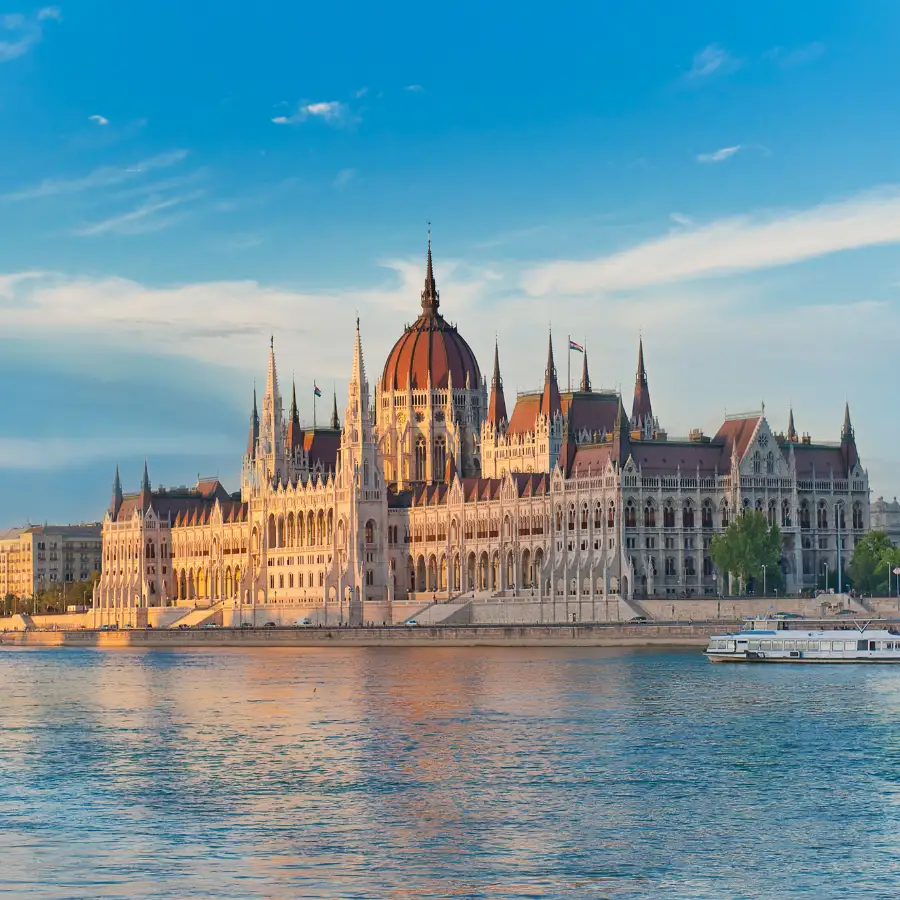
Day 1
Arrive Budapest
Day 1
Arrive Budapest



To Be Determined
Private Budapest Airport Pickup
We will schedule a pick up for 30 minutes after your flight's arrival time. You will be met in the terminal by a driver holding a sign with your name on it. The ride is for your party only - you will not be sharing a vehicle. The cost of the ride is included in your package, and you will not have to pay the driver. IMPORTANT NOTE: Please be aware the car service can fit up to 1 checked item of luggage and 1 personal item per person, such as a purse or small backpack. If you think you will have more baggage, please inform your travel consultant as this may result in an additional fee.

Day 1
Arrive Budapest


Day 1
Arrive Budapest




To Be Determined:
Private Budapest Airport Pickup
Mid-Day/Afternoon:
Hungarian Parliament & Nearby
Late Afternoon/Early Evening:
Central Market & Váci Street

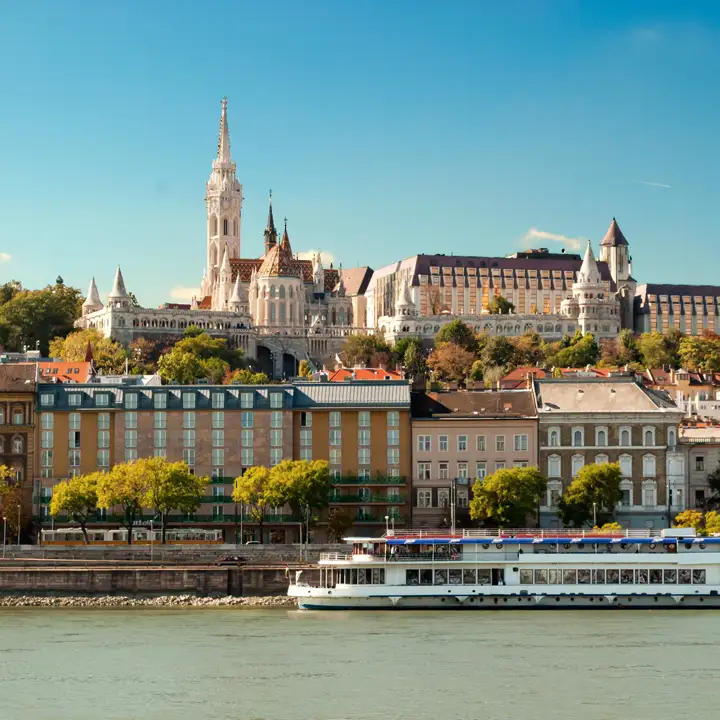
Day 2
Budapest
Day 2
Budapest



9:00 AM - 12:30 PM
Guided Walk in Budapest
During your tour you will take in a gorgeous vista of the city from the Fisherman's Bastion, explore the winding streets of the Castle District, gaze in awe at the striking interior of St. Stephen's Basilica, travel along the city's most elegant avenue and more. Along the way you will experience the city as a local does, stopping to check out intimate courtyards, enjoying a pastry and soaking in the ambiance of Budapest's most elegant cafes.

Day 2
Budapest



Day 3
Budapest to Vienna
Day 3
Budapest to Vienna





Morning/Mid-Day
Central Pest
In Central Pest you will discover the beating heart of the city, with grand apartment houses and art nouveau architectural gems. No visit to Budapest is complete without seeing its highlights, including St. Stephen's Basilica, which dramatically rises above the city, and the Chain Bridge, which regally spans the Danube.

Café Gerbeaud
Enjoy a leisurely coffee and cake in one of Budapest's most storied cafes.
Show More

Gresham Palace
Take a peak at this pearl of art nouveau architecture, which now houses a Four Seasons Hotel.
Show More

St. Stephen's Basilica
Enjoy an awe-inspiring visit to this vast cupola-topped church; the most famous in Budapest.
Show More

Széchenyi Chain Bridge
Stroll across a beautiful landmark 19th-century suspension bridge which is a symbol of Budapest.
Show More

Café Gerbeaud
Enjoy a leisurely coffee and cake in one of Budapest's most storied cafes.
Show More

Gresham Palace
Take a peak at this pearl of art nouveau architecture, which now houses a Four Seasons Hotel.
Show More

St. Stephen's Basilica
Enjoy an awe-inspiring visit to this vast cupola-topped church; the most famous in Budapest.
Show More

Széchenyi Chain Bridge
Stroll across a beautiful landmark 19th-century suspension bridge which is a symbol of Budapest.
Show More
prev
next

Day 3
Budapest to Vienna


Café Gerbeaud
 Highlight of Central Pest
Highlight of Central PestEnjoy a leisurely coffee and cake in one of Budapest's most storied cafes.
Over 160 years old, with a grand, high-ceilinged dining room, the cafe is deservedly one of Budapest's most popular attractions. It serves coffee, mouthwatering Hungarian pastries, and traditional bistro dishes. It retains the elegance and sophistication of its 19th century origins, and the terrace sits on the lively Vörösmarty Square.
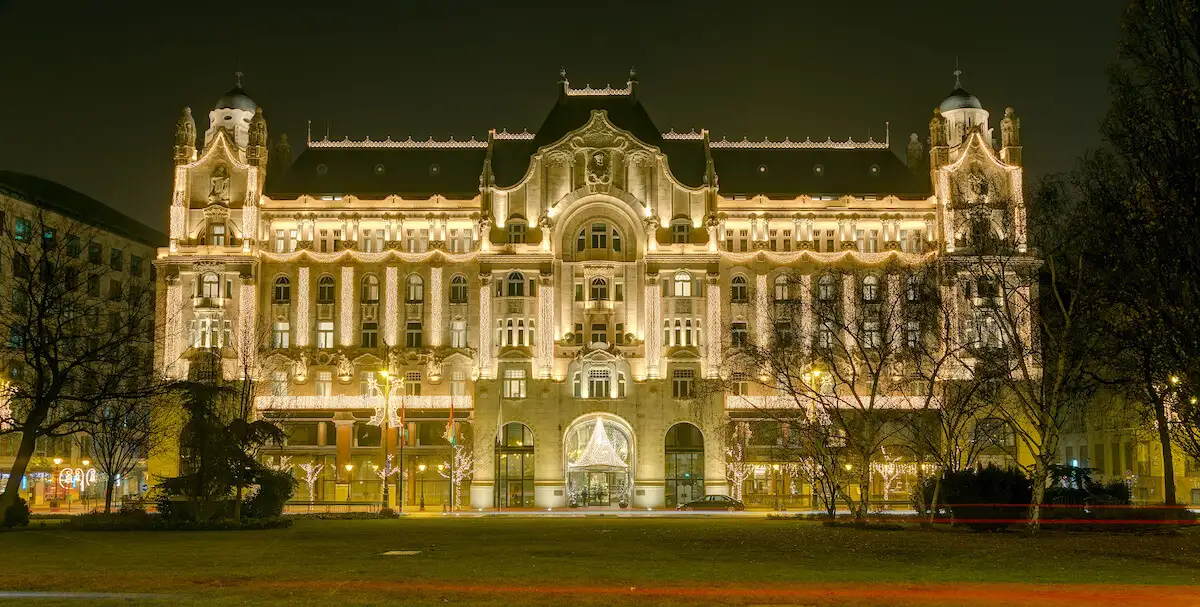
Gresham Palace
 Highlight of Central Pest
Highlight of Central PestTake a peak at this pearl of art nouveau architecture, which now houses a Four Seasons Hotel.
The hotel doesn't mind tourists exploring the lavish arcade on the first floor, as it is lined by shops and a café. Be sure to note the organic themes of the façade and the beautiful wrought iron peacock gate on the north side of the building.

St. Stephen's Basilica
 Highlight of Central Pest
Highlight of Central PestEnjoy an awe-inspiring visit to this vast cupola-topped church; the most famous in Budapest.
Completed in 1905, the construction of the neo-classical Catholic church took over 50 years. The mummified hand of Hungary's first king, St. Stephen, is kept in a small chapel in the rear. Take a lift to the dome to enjoy one of Budapest's most interesting panoramic views. The church hosts frequent concerts.
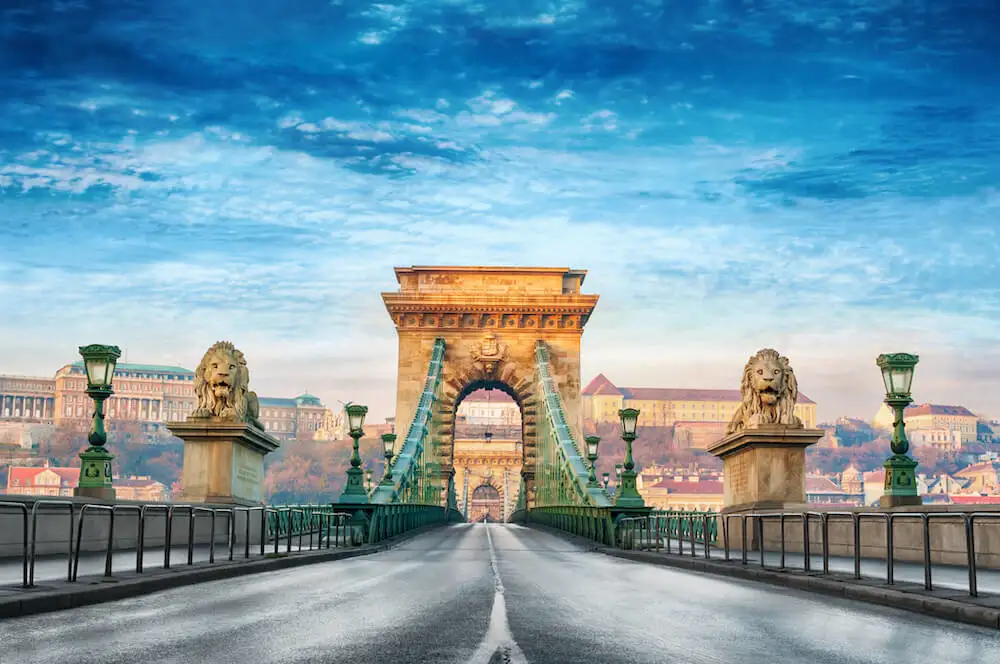
Széchenyi Chain Bridge
 Highlight of Central Pest
Highlight of Central PestStroll across a beautiful landmark 19th-century suspension bridge which is a symbol of Budapest.
This was Budapest's first permanent bridge over the Danube, enabling the cities of Buda and Pest to merge. Named after Count István Széchenyi, it hangs from iron chains (hence, the Chain Bridge) anchored by two towering river piers. These piers were the only elements to survive WWII fighting. The rest was rebuilt.

Café Gerbeaud
 Highlight of Central Pest
Highlight of Central PestEnjoy a leisurely coffee and cake in one of Budapest's most storied cafes.
Over 160 years old, with a grand, high-ceilinged dining room, the cafe is deservedly one of Budapest's most popular attractions. It serves coffee, mouthwatering Hungarian pastries, and traditional bistro dishes. It retains the elegance and sophistication of its 19th century origins, and the terrace sits on the lively Vörösmarty Square.

Gresham Palace
 Highlight of Central Pest
Highlight of Central PestTake a peak at this pearl of art nouveau architecture, which now houses a Four Seasons Hotel.
The hotel doesn't mind tourists exploring the lavish arcade on the first floor, as it is lined by shops and a café. Be sure to note the organic themes of the façade and the beautiful wrought iron peacock gate on the north side of the building.

St. Stephen's Basilica
 Highlight of Central Pest
Highlight of Central PestEnjoy an awe-inspiring visit to this vast cupola-topped church; the most famous in Budapest.
Completed in 1905, the construction of the neo-classical Catholic church took over 50 years. The mummified hand of Hungary's first king, St. Stephen, is kept in a small chapel in the rear. Take a lift to the dome to enjoy one of Budapest's most interesting panoramic views. The church hosts frequent concerts.

Széchenyi Chain Bridge
 Highlight of Central Pest
Highlight of Central PestStroll across a beautiful landmark 19th-century suspension bridge which is a symbol of Budapest.
This was Budapest's first permanent bridge over the Danube, enabling the cities of Buda and Pest to merge. Named after Count István Széchenyi, it hangs from iron chains (hence, the Chain Bridge) anchored by two towering river piers. These piers were the only elements to survive WWII fighting. The rest was rebuilt.
prev
next


Day 4
Vienna
Day 4
Vienna



9:00 AM - 11:30 AM
Guided Walk of the Inner City
This tour takes you back in history to explore the Vienna that stood within the old city walls. You will learn about the humble beginnings of Vienna before it became the capital of a great empire and one of the most important cities in Europe. You will discover how Vienna's early inhabitants lived and how they left their mark on the city and its beautiful Medieval, Renaissance, and Baroque architecture.

Day 4
Vienna



Day 5
Vienna
Day 5
Vienna



Morning/Mid-Day
Ring Street
The Ringstrasse, or the Ring Street, surrounds Vienna's old town where the city walls once stood until the 19th century. The Austro-Hungarian Empire was at the height of its prosperity at the time the walls were torn down, and so it lined the wide Ringstrasse with monumental buildings such as the neo-Gothic town hall and neo-Classical parliament buildling. A fun experience is to take a tram ride around the entire length of the Ringstrasse, soaking in the full richness of the spectacle.

Natural History Museum
Explore one of the world's most important natural history collections.
Show More

Kunsthistorisches Museum
Find artistic bliss in this lavish 19th-century museum housing art collections & antiquities.
Show More

Rathaus (City Hall)
Get in touch with the local vibe at the Rathausplatz, a huge square in front of the Vienna City Hall.
Show More

Natural History Museum
Explore one of the world's most important natural history collections.
Show More

Kunsthistorisches Museum
Find artistic bliss in this lavish 19th-century museum housing art collections & antiquities.
Show More

Rathaus (City Hall)
Get in touch with the local vibe at the Rathausplatz, a huge square in front of the Vienna City Hall.
Show More

Natural History Museum
Explore one of the world's most important natural history collections.
Show More
prev
next

Day 5
Vienna


Natural History Museum
 Highlight of Ring Street
Highlight of Ring StreetExplore one of the world's most important natural history collections.
The museum is a treasure trove of anthropological and archeological exhibits, including dinosaurs and other extinct animals, precious gems, and more. It also holds the famous pre-historic finds from the Austrian village of Hallstatt, where an ancient salt mine was located.

Kunsthistorisches Museum
 Highlight of Ring Street
Highlight of Ring StreetFind artistic bliss in this lavish 19th-century museum housing art collections & antiquities.
The Kunsthistorisches Museum, or Art History Museum, is one of the world's most important collections of art. It houses many masterpieces as well as ancient and classical art antiquities. Its amazing interior is worth seeing just on its own merits, and includes an incredible mural painted by Gustav Klimt.
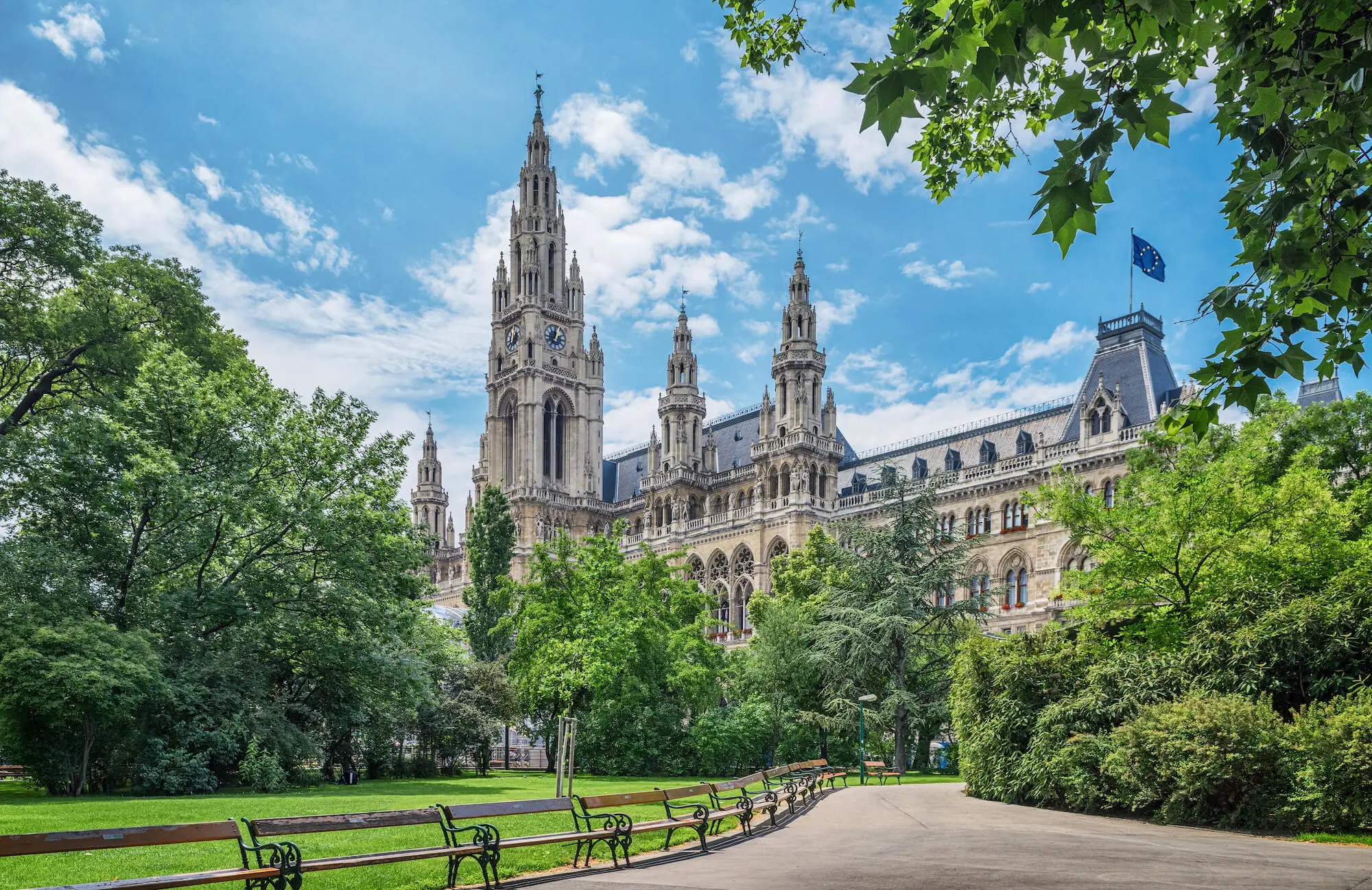
Rathaus (City Hall)
 Highlight of Ring Street
Highlight of Ring StreetGet in touch with the local vibe at the Rathausplatz, a huge square in front of the Vienna City Hall.
The 19th-century city hall was built in a fanciful neo-Gothic style with 30 million bricks. It is an important center for social life in the city, hosting balls, concerts, and other events. The square in front of the hall is home to activities all year long, including markets, food fairs, exhibitions, and the city's biggest Christmas Market.

Natural History Museum
 Highlight of Ring Street
Highlight of Ring StreetExplore one of the world's most important natural history collections.
The museum is a treasure trove of anthropological and archeological exhibits, including dinosaurs and other extinct animals, precious gems, and more. It also holds the famous pre-historic finds from the Austrian village of Hallstatt, where an ancient salt mine was located.

Kunsthistorisches Museum
 Highlight of Ring Street
Highlight of Ring StreetFind artistic bliss in this lavish 19th-century museum housing art collections & antiquities.
The Kunsthistorisches Museum, or Art History Museum, is one of the world's most important collections of art. It houses many masterpieces as well as ancient and classical art antiquities. Its amazing interior is worth seeing just on its own merits, and includes an incredible mural painted by Gustav Klimt.

Rathaus (City Hall)
 Highlight of Ring Street
Highlight of Ring StreetGet in touch with the local vibe at the Rathausplatz, a huge square in front of the Vienna City Hall.
The 19th-century city hall was built in a fanciful neo-Gothic style with 30 million bricks. It is an important center for social life in the city, hosting balls, concerts, and other events. The square in front of the hall is home to activities all year long, including markets, food fairs, exhibitions, and the city's biggest Christmas Market.

Natural History Museum
 Highlight of Ring Street
Highlight of Ring StreetExplore one of the world's most important natural history collections.
The museum is a treasure trove of anthropological and archeological exhibits, including dinosaurs and other extinct animals, precious gems, and more. It also holds the famous pre-historic finds from the Austrian village of Hallstatt, where an ancient salt mine was located.
prev
next


Day 6
Vienna to Prague
Day 6
Vienna to Prague





Morning/Mid-Day
Karlskirche & Belvedere Palace
Two of Vienna's greatest architectural treasures lie just beyond the Ring Street - the Belvedere Palace and the Karlskirche (St. Charles's Church). Often missed by visitors, these Baroque wonders represent Austria at the peak of its prestige and power and deserve to be on every visitor's list.

Belvedere Palace
Stroll the Belvedere's gardens, and venture inside the palace for a "Kiss".
Show More

Karlskirche
Many argue that this baroque church is as beautiful as St. Peter's - see it and decide for yourself.
Show More

Belvedere Palace
Stroll the Belvedere's gardens, and venture inside the palace for a "Kiss".
Show More

Karlskirche
Many argue that this baroque church is as beautiful as St. Peter's - see it and decide for yourself.
Show More

Belvedere Palace
Stroll the Belvedere's gardens, and venture inside the palace for a "Kiss".
Show More

Karlskirche
Many argue that this baroque church is as beautiful as St. Peter's - see it and decide for yourself.
Show More
prev
next

Day 6
Vienna to Prague


Belvedere Palace
 Highlight of Karlskirche & Belvedere Palace
Highlight of Karlskirche & Belvedere PalaceStroll the Belvedere's gardens, and venture inside the palace for a "Kiss".
Two Baraque palaces are connected by a French-style, three-level garden which features delightful fountains. Originally built as a summer residence of Prince Eugene, it now houses the Belvedere Museum where you will find Gustav Klimt's most famous work - The Kiss.

Karlskirche
 Highlight of Karlskirche & Belvedere Palace
Highlight of Karlskirche & Belvedere PalaceMany argue that this baroque church is as beautiful as St. Peter's - see it and decide for yourself.
Built between 1716-1737, Emperor Charles VI intended the church to be a thanksgiving for the end of a plague epidemic and dedicated the church to St. Charles Borromeo, who is revered for his care of plague victims. St. Charles was also his namesake, meaning that the church's name evokes the emperor's memory as much as the saint's, which was no accident. Indeed, the two columns in front of the church are meant to represent imperial power.

Belvedere Palace
 Highlight of Karlskirche & Belvedere Palace
Highlight of Karlskirche & Belvedere PalaceStroll the Belvedere's gardens, and venture inside the palace for a "Kiss".
Two Baraque palaces are connected by a French-style, three-level garden which features delightful fountains. Originally built as a summer residence of Prince Eugene, it now houses the Belvedere Museum where you will find Gustav Klimt's most famous work - The Kiss.

Karlskirche
 Highlight of Karlskirche & Belvedere Palace
Highlight of Karlskirche & Belvedere PalaceMany argue that this baroque church is as beautiful as St. Peter's - see it and decide for yourself.
Built between 1716-1737, Emperor Charles VI intended the church to be a thanksgiving for the end of a plague epidemic and dedicated the church to St. Charles Borromeo, who is revered for his care of plague victims. St. Charles was also his namesake, meaning that the church's name evokes the emperor's memory as much as the saint's, which was no accident. Indeed, the two columns in front of the church are meant to represent imperial power.

Belvedere Palace
 Highlight of Karlskirche & Belvedere Palace
Highlight of Karlskirche & Belvedere PalaceStroll the Belvedere's gardens, and venture inside the palace for a "Kiss".
Two Baraque palaces are connected by a French-style, three-level garden which features delightful fountains. Originally built as a summer residence of Prince Eugene, it now houses the Belvedere Museum where you will find Gustav Klimt's most famous work - The Kiss.

Karlskirche
 Highlight of Karlskirche & Belvedere Palace
Highlight of Karlskirche & Belvedere PalaceMany argue that this baroque church is as beautiful as St. Peter's - see it and decide for yourself.
Built between 1716-1737, Emperor Charles VI intended the church to be a thanksgiving for the end of a plague epidemic and dedicated the church to St. Charles Borromeo, who is revered for his care of plague victims. St. Charles was also his namesake, meaning that the church's name evokes the emperor's memory as much as the saint's, which was no accident. Indeed, the two columns in front of the church are meant to represent imperial power.
prev
next


Day 7
Prague
Day 7
Prague



9:00 AM - 12:30 PM
Royal Route Guided Tour
On this charming guided walk, you will explore the Prague Castle, the largest castle complex in all of Europe. To reach the castle you will trace the Royal Coronation Route and cross the Charles Bridge, whose “speaking stones” reveal the amazing and often cruel history that occurred there. Your tour guide will then take you either through the castle courtyards and into the dramatic St. Vitus Cathedral in the center of the castle complex, or through the upper part of the castle district around the oversized palaces of the old Catholic nobility and the top of the Castle Steps for incomparable views over the red rooftops of the Little Quarter.

Charles Bridge
Cross the river dividing Prague's most historic neighborhoods, and experience one of Europe's most iconic landmarks.
Show More

Maltese Square & Lennon Wall
See a historic wall that has been covered in John Lennon-inspired graffiti since Communist days.
Show More

Prague Castle
Prague Castle is one of the main attractions in Prague and is also the largest castle complex in the world.
Show More

Charles Bridge
Cross the river dividing Prague's most historic neighborhoods, and experience one of Europe's most iconic landmarks.
Show More

Maltese Square & Lennon Wall
See a historic wall that has been covered in John Lennon-inspired graffiti since Communist days.
Show More

Prague Castle
Prague Castle is one of the main attractions in Prague and is also the largest castle complex in the world.
Show More

Charles Bridge
Cross the river dividing Prague's most historic neighborhoods, and experience one of Europe's most iconic landmarks.
Show More
prev
next

Day 7
Prague

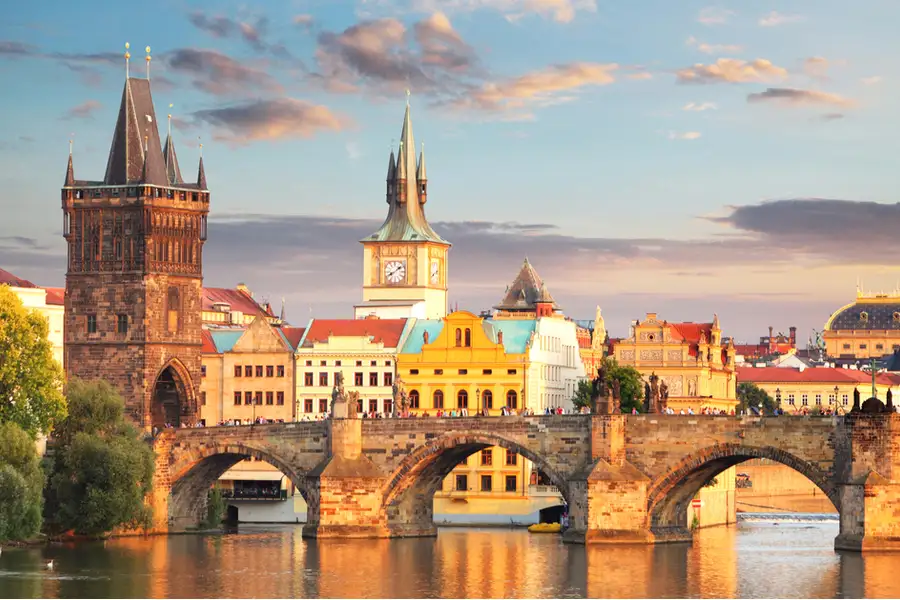
Charles Bridge
 Highlight of Royal Route Guided Tour
Highlight of Royal Route Guided TourCross the river dividing Prague's most historic neighborhoods, and experience one of Europe's most iconic landmarks.
Bridge construction began in 1357 under King Charles IV (hence the name), and it was the only bridge across the Vltava River until 1841. 30 baroque statues of saints line the bridge, and it is filled with street artists and entertainers. Not to be missed.

Maltese Square & Lennon Wall
 Highlight of Royal Route Guided Tour
Highlight of Royal Route Guided TourSee a historic wall that has been covered in John Lennon-inspired graffiti since Communist days.
The wall has been covered in graffiti since the 1960s, and during Communism anti-regime sentiment was common. John Lennon's assassination inspired grafitti reflecting his song, Imagine, which earned the wall its current moniker. It is now a favorite gathering place for tourists, and musicians sometimes congregate there as well. Just around the corner is the Maltese Square, which is one of Prague's more quaint and relaxed public spaces, despite being just off the main tourist route.

Prague Castle
 Highlight of Royal Route Guided Tour
Highlight of Royal Route Guided TourPrague Castle is one of the main attractions in Prague and is also the largest castle complex in the world.
The Prague Castle is the largest castle complex in the world with structures dating back to the 9th century. The St Vitus Cathedral and Basilica of St George can be found within the castle walls. The Prague Castle also includes several gardens, palaces, and a monastery. This castle was the seat of power for the Kings of Bohemia, Holy Roman Emperors, and presidents of former Czechoslovakia. Prague Castle is a UNESCO world heritage site and is one of the most visited places in the country.

Charles Bridge
 Highlight of Royal Route Guided Tour
Highlight of Royal Route Guided TourCross the river dividing Prague's most historic neighborhoods, and experience one of Europe's most iconic landmarks.
Bridge construction began in 1357 under King Charles IV (hence the name), and it was the only bridge across the Vltava River until 1841. 30 baroque statues of saints line the bridge, and it is filled with street artists and entertainers. Not to be missed.

Maltese Square & Lennon Wall
 Highlight of Royal Route Guided Tour
Highlight of Royal Route Guided TourSee a historic wall that has been covered in John Lennon-inspired graffiti since Communist days.
The wall has been covered in graffiti since the 1960s, and during Communism anti-regime sentiment was common. John Lennon's assassination inspired grafitti reflecting his song, Imagine, which earned the wall its current moniker. It is now a favorite gathering place for tourists, and musicians sometimes congregate there as well. Just around the corner is the Maltese Square, which is one of Prague's more quaint and relaxed public spaces, despite being just off the main tourist route.

Prague Castle
 Highlight of Royal Route Guided Tour
Highlight of Royal Route Guided TourPrague Castle is one of the main attractions in Prague and is also the largest castle complex in the world.
The Prague Castle is the largest castle complex in the world with structures dating back to the 9th century. The St Vitus Cathedral and Basilica of St George can be found within the castle walls. The Prague Castle also includes several gardens, palaces, and a monastery. This castle was the seat of power for the Kings of Bohemia, Holy Roman Emperors, and presidents of former Czechoslovakia. Prague Castle is a UNESCO world heritage site and is one of the most visited places in the country.

Charles Bridge
 Highlight of Royal Route Guided Tour
Highlight of Royal Route Guided TourCross the river dividing Prague's most historic neighborhoods, and experience one of Europe's most iconic landmarks.
Bridge construction began in 1357 under King Charles IV (hence the name), and it was the only bridge across the Vltava River until 1841. 30 baroque statues of saints line the bridge, and it is filled with street artists and entertainers. Not to be missed.
prev
next


Day 8
Prague
Day 8
Prague



Morning/Mid-Day
New Town
Despite being 700 years old, the New Town (Nové Město) is the youngest of the original five independent towns that made up Medieval Prague. The heart of New Town is one of the three original markets around which the town was planned, Wenceslas Square. Not fully given over to tourism like the Old Town, the New Town combines a historic atmosphere with the daily commercial and social life of locals, making it a great place to get a taste of the real Prague.

Dancing House
Stroll down the river to find this curvaceous office block designed by Frank Gehry, and whi msically nicknamed Fred & Ginger.
Show More

National Theater
Experience nationally-sponsored ballet & opera in a magnificent venue.
Show More

National Museum
Explore an interesting museum collection in a grand building completed in 1891.
Show More

Wenceslas Square
Experience a mishmash of interesting architecture on Wenceslas Square, Prague's main commercial center.
Show More

Municipal House
Tour a breathtaking art nouveau venue and stay for a concert, opera, or ballet.
Show More

Dancing House
Stroll down the river to find this curvaceous office block designed by Frank Gehry, and whi msically nicknamed Fred & Ginger.
Show More

National Theater
Experience nationally-sponsored ballet & opera in a magnificent venue.
Show More

National Museum
Explore an interesting museum collection in a grand building completed in 1891.
Show More

Wenceslas Square
Experience a mishmash of interesting architecture on Wenceslas Square, Prague's main commercial center.
Show More

Municipal House
Tour a breathtaking art nouveau venue and stay for a concert, opera, or ballet.
Show More

Dancing House
Stroll down the river to find this curvaceous office block designed by Frank Gehry, and whi msically nicknamed Fred & Ginger.
Show More
prev
next

Day 8
Prague


Dancing House
 Highlight of New Town
Highlight of New TownStroll down the river to find this curvaceous office block designed by Frank Gehry, and whi msically nicknamed Fred & Ginger.
There is no tour of the interior, so most visitors just snap a photo and head out. However, there is a restaurant and bar at the top called Ginger&Fred. For a spectacular view of the city check out the terrace on the top floor (only for paying customers).

National Theater
 Highlight of New Town
Highlight of New TownExperience nationally-sponsored ballet & opera in a magnificent venue.
This concert hall is Prague's most prestigious, and it is not only a symbol of the 19th century Czech national revival but also arguably one of the most beautiful concert venues in Europe. Unfortunately, tours are not regularly offered, but you may attend an opera or ballet if you purchase tickets in advance. The riverfront near the concert hall is one of the most photographed spots in Prague.

National Museum
 Highlight of New Town
Highlight of New TownExplore an interesting museum collection in a grand building completed in 1891.
The recently renovated and improved National Museum is fronted by the iconic equestrian statue of "good king Wenceslas". Beyond it's dramatic exterior you'll find a grand staircase which is a highlight of any visit. Founded in 1818, the museum played a major role in bringing natural science and history to the common man, and also played an important part in the Czech national revival occurring in the 19th century.

Wenceslas Square
 Highlight of New Town
Highlight of New TownExperience a mishmash of interesting architecture on Wenceslas Square, Prague's main commercial center.
The square, which could also be described as a wide boulevard, is named after the Patron Saint of Bohemia, whose statue can be seen at the top of the square. Many historical events have taken place here, including the demonstrations of the Velvet Revolution in 1989, which resulted in the collapse of the Communist regime. Today the square is lined by department stores, hotels, and office buildings, many of them notable architectural highlights of the 19th, 20th, and 21st century.

Municipal House
 Highlight of New Town
Highlight of New TownTour a breathtaking art nouveau venue and stay for a concert, opera, or ballet.
The stunning concert hall is open for tours and hosts performances on most evenings. The main hall is painted by famous Czech artists including Alfons Mucha. A beautiful cafe and restaurant are also housed in the building, and you can find one of Prague's most ornate pubs in the cellar (the "American Bar").

Dancing House
 Highlight of New Town
Highlight of New TownStroll down the river to find this curvaceous office block designed by Frank Gehry, and whi msically nicknamed Fred & Ginger.
There is no tour of the interior, so most visitors just snap a photo and head out. However, there is a restaurant and bar at the top called Ginger&Fred. For a spectacular view of the city check out the terrace on the top floor (only for paying customers).

National Theater
 Highlight of New Town
Highlight of New TownExperience nationally-sponsored ballet & opera in a magnificent venue.
This concert hall is Prague's most prestigious, and it is not only a symbol of the 19th century Czech national revival but also arguably one of the most beautiful concert venues in Europe. Unfortunately, tours are not regularly offered, but you may attend an opera or ballet if you purchase tickets in advance. The riverfront near the concert hall is one of the most photographed spots in Prague.

National Museum
 Highlight of New Town
Highlight of New TownExplore an interesting museum collection in a grand building completed in 1891.
The recently renovated and improved National Museum is fronted by the iconic equestrian statue of "good king Wenceslas". Beyond it's dramatic exterior you'll find a grand staircase which is a highlight of any visit. Founded in 1818, the museum played a major role in bringing natural science and history to the common man, and also played an important part in the Czech national revival occurring in the 19th century.

Wenceslas Square
 Highlight of New Town
Highlight of New TownExperience a mishmash of interesting architecture on Wenceslas Square, Prague's main commercial center.
The square, which could also be described as a wide boulevard, is named after the Patron Saint of Bohemia, whose statue can be seen at the top of the square. Many historical events have taken place here, including the demonstrations of the Velvet Revolution in 1989, which resulted in the collapse of the Communist regime. Today the square is lined by department stores, hotels, and office buildings, many of them notable architectural highlights of the 19th, 20th, and 21st century.

Municipal House
 Highlight of New Town
Highlight of New TownTour a breathtaking art nouveau venue and stay for a concert, opera, or ballet.
The stunning concert hall is open for tours and hosts performances on most evenings. The main hall is painted by famous Czech artists including Alfons Mucha. A beautiful cafe and restaurant are also housed in the building, and you can find one of Prague's most ornate pubs in the cellar (the "American Bar").

Dancing House
 Highlight of New Town
Highlight of New TownStroll down the river to find this curvaceous office block designed by Frank Gehry, and whi msically nicknamed Fred & Ginger.
There is no tour of the interior, so most visitors just snap a photo and head out. However, there is a restaurant and bar at the top called Ginger&Fred. For a spectacular view of the city check out the terrace on the top floor (only for paying customers).
prev
next

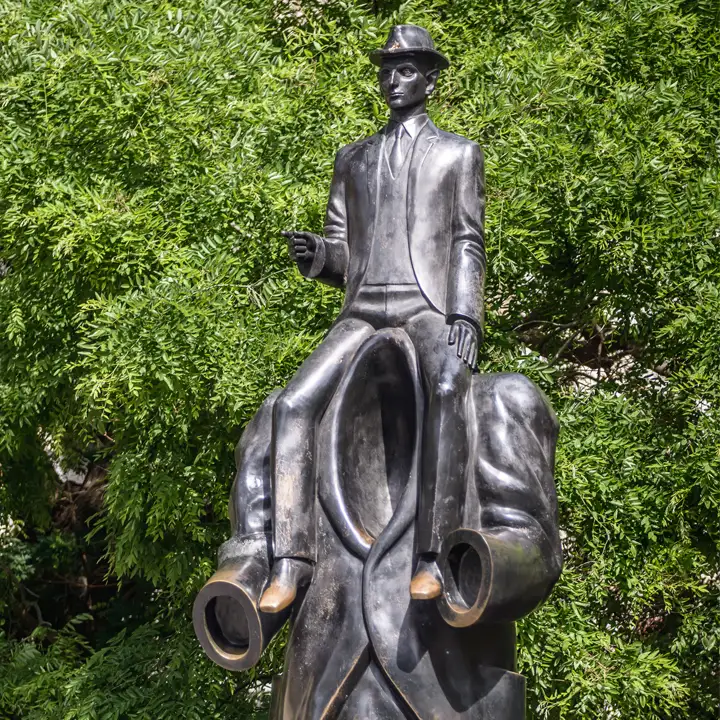
Day 9
Prague
Day 9
Prague





Morning/Mid-Day
Jewish Quarter
Jews have lived in Prague since its beginnings in the 10th century and have endowed it with a rich heritage. The ghetto was created in the 12th century, as Jews were forced to live separately from Christians. Despite persecution, the community prospered, but sadly, only a small minority survived the Nazi occupation. A lasting legacy remains, including synagogues, architecture, and a fascinating cemetery.

Spanish Synagogue
Discover the synagogue considered by many to be Prague's most beautiful.
Show More

Old-New Synagogue
See the oldest surviving synagogue in Europe and also one of Prague's earliest Gothic buildings.
Show More

Old Jewish Cemetery
Take an unforgettable visit to one of Europe's largest medieval Jewish cemeteries.
Show More

Spanish Synagogue
Discover the synagogue considered by many to be Prague's most beautiful.
Show More

Old-New Synagogue
See the oldest surviving synagogue in Europe and also one of Prague's earliest Gothic buildings.
Show More

Old Jewish Cemetery
Take an unforgettable visit to one of Europe's largest medieval Jewish cemeteries.
Show More

Spanish Synagogue
Discover the synagogue considered by many to be Prague's most beautiful.
Show More
prev
next

Day 9
Prague


Spanish Synagogue
 Highlight of Jewish Quarter
Highlight of Jewish QuarterDiscover the synagogue considered by many to be Prague's most beautiful.
Completed in 1868, the Spanish Synagogue is the newest synagogue in Prague's Jewish Quarter, but happens to be built on the site of the former Oldest Synagogue in Prague. It is built in a stunning Spanish Moorish style as a symbol of the flowering of the Jewish culture which occurred under Muslim rule on the Iberian Peninsula.

Old-New Synagogue
 Highlight of Jewish Quarter
Highlight of Jewish QuarterSee the oldest surviving synagogue in Europe and also one of Prague's earliest Gothic buildings.
When built it was Prague’s newest synagogue, but over time became its oldest – hence the “Old-New”. A beautiful ark holds the Torah and legend says its attic is the hiding place of the legendary clay Golem.

Old Jewish Cemetery
 Highlight of Jewish Quarter
Highlight of Jewish QuarterTake an unforgettable visit to one of Europe's largest medieval Jewish cemeteries.
As the Jewish Ghetto was quite cramped, there was no room to expand the cemetery. Unable to acquire further land, and not wishing to dishonor ancestors through the demolition of existing graves, Prague's Jews buried their loved ones in multiple levels. Gravestones are packed in tightly and in some areas the burials reach 12 layers!

Spanish Synagogue
 Highlight of Jewish Quarter
Highlight of Jewish QuarterDiscover the synagogue considered by many to be Prague's most beautiful.
Completed in 1868, the Spanish Synagogue is the newest synagogue in Prague's Jewish Quarter, but happens to be built on the site of the former Oldest Synagogue in Prague. It is built in a stunning Spanish Moorish style as a symbol of the flowering of the Jewish culture which occurred under Muslim rule on the Iberian Peninsula.

Old-New Synagogue
 Highlight of Jewish Quarter
Highlight of Jewish QuarterSee the oldest surviving synagogue in Europe and also one of Prague's earliest Gothic buildings.
When built it was Prague’s newest synagogue, but over time became its oldest – hence the “Old-New”. A beautiful ark holds the Torah and legend says its attic is the hiding place of the legendary clay Golem.

Old Jewish Cemetery
 Highlight of Jewish Quarter
Highlight of Jewish QuarterTake an unforgettable visit to one of Europe's largest medieval Jewish cemeteries.
As the Jewish Ghetto was quite cramped, there was no room to expand the cemetery. Unable to acquire further land, and not wishing to dishonor ancestors through the demolition of existing graves, Prague's Jews buried their loved ones in multiple levels. Gravestones are packed in tightly and in some areas the burials reach 12 layers!

Spanish Synagogue
 Highlight of Jewish Quarter
Highlight of Jewish QuarterDiscover the synagogue considered by many to be Prague's most beautiful.
Completed in 1868, the Spanish Synagogue is the newest synagogue in Prague's Jewish Quarter, but happens to be built on the site of the former Oldest Synagogue in Prague. It is built in a stunning Spanish Moorish style as a symbol of the flowering of the Jewish culture which occurred under Muslim rule on the Iberian Peninsula.
prev
next

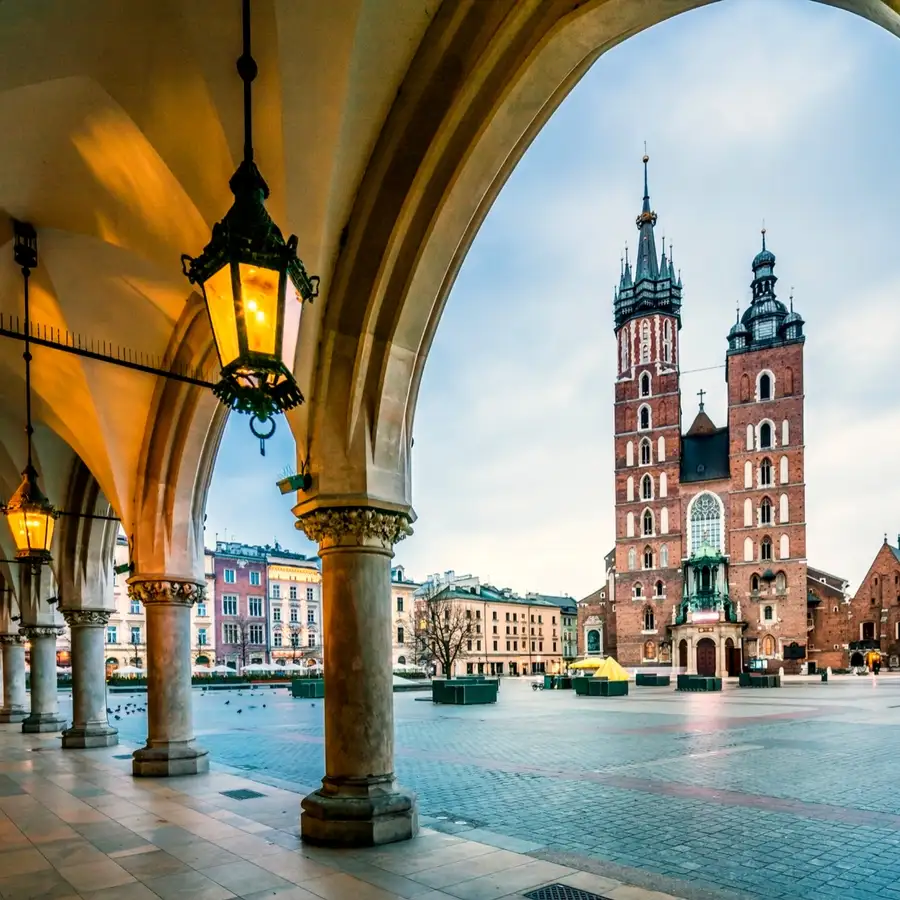
Day 10
Krakow
Day 10
Krakow




6:10 AM
Hotel Transfer from Krakow Rail Station
Upon your arrival in Krakow, your driver will meet you on the platform. He will be carrying a sign with your name on it. The driver will drop you off at your hotel. This is a private transfer. The price of the pickup is already included in your itinerary cost so you will not have to pay the driver. IMPORTANT NOTE: Please be aware the car service can fit up to 1 checked item of luggage and 1 personal item per person, such as a purse or small backpack. If you think you will have more baggage, please inform your travel consultant as this may result in an additional fee.

Day 10
Krakow


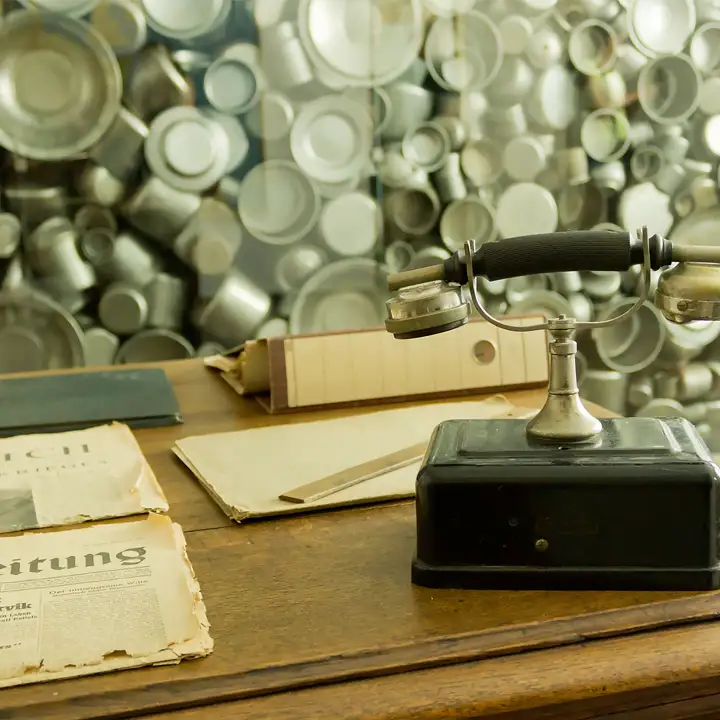
Day 11
Krakow
Day 11
Krakow


Early Morning/Morning
Schindler's Factory Museum
During World War II Oscar Schindler saved the lives of more than 1,100 Jews by employing them in his enamelware factory in Krakow. Until recently still used as a factory, the building now houses one of Europe's most impressive new museums. It tells not only the story of Schindler and the Jews he protected, but of the wider experience of Krakow during World War II.

Podgórze
Wander the streets of the former Jewish Ghetto.
Show More

Podgórze
Wander the streets of the former Jewish Ghetto.
Show More

Podgórze
Wander the streets of the former Jewish Ghetto.
Show More

Podgórze
Wander the streets of the former Jewish Ghetto.
Show More

Podgórze
Wander the streets of the former Jewish Ghetto.
Show More
prev
next

Day 11
Krakow


Podgórze
 Highlight of Schindler's Factory Museum
Highlight of Schindler's Factory MuseumWander the streets of the former Jewish Ghetto.
Podgórze is the neighborhood where the Krakow Jewish Ghetto was located. At the beginning of the war, only about 3,000 people lived in the district, but over 15,000 Jews were forcibly moved there and surrounded by tall walls and guarded gates. In 1942-3 the ghetto was "liquidated", with residents sent to either labor camps or extermination camps, or simply murdered in the streets. A couple small sections of the wall and a memorial of empty chairs (each chair representing a 1,000 victims) on the ghetto square are among the very few remaining physical reminders of the ghetto. On the corner of the square, you can also visit the small museum of the Apteka pod Orlem (Pharmacy under the Eagle), which was the only pharmacy allowed to operate in the ghetto. The Polish Catholic owner requested permission to operate within the ghetto and provided medical supplies to residents, often for free. Both he and Oscar Schindler were honored by Israel as "Righteous Among the Nations".

Podgórze
 Highlight of Schindler's Factory Museum
Highlight of Schindler's Factory MuseumWander the streets of the former Jewish Ghetto.
Podgórze is the neighborhood where the Krakow Jewish Ghetto was located. At the beginning of the war, only about 3,000 people lived in the district, but over 15,000 Jews were forcibly moved there and surrounded by tall walls and guarded gates. In 1942-3 the ghetto was "liquidated", with residents sent to either labor camps or extermination camps, or simply murdered in the streets. A couple small sections of the wall and a memorial of empty chairs (each chair representing a 1,000 victims) on the ghetto square are among the very few remaining physical reminders of the ghetto. On the corner of the square, you can also visit the small museum of the Apteka pod Orlem (Pharmacy under the Eagle), which was the only pharmacy allowed to operate in the ghetto. The Polish Catholic owner requested permission to operate within the ghetto and provided medical supplies to residents, often for free. Both he and Oscar Schindler were honored by Israel as "Righteous Among the Nations".

Podgórze
 Highlight of Schindler's Factory Museum
Highlight of Schindler's Factory MuseumWander the streets of the former Jewish Ghetto.
Podgórze is the neighborhood where the Krakow Jewish Ghetto was located. At the beginning of the war, only about 3,000 people lived in the district, but over 15,000 Jews were forcibly moved there and surrounded by tall walls and guarded gates. In 1942-3 the ghetto was "liquidated", with residents sent to either labor camps or extermination camps, or simply murdered in the streets. A couple small sections of the wall and a memorial of empty chairs (each chair representing a 1,000 victims) on the ghetto square are among the very few remaining physical reminders of the ghetto. On the corner of the square, you can also visit the small museum of the Apteka pod Orlem (Pharmacy under the Eagle), which was the only pharmacy allowed to operate in the ghetto. The Polish Catholic owner requested permission to operate within the ghetto and provided medical supplies to residents, often for free. Both he and Oscar Schindler were honored by Israel as "Righteous Among the Nations".

Podgórze
 Highlight of Schindler's Factory Museum
Highlight of Schindler's Factory MuseumWander the streets of the former Jewish Ghetto.
Podgórze is the neighborhood where the Krakow Jewish Ghetto was located. At the beginning of the war, only about 3,000 people lived in the district, but over 15,000 Jews were forcibly moved there and surrounded by tall walls and guarded gates. In 1942-3 the ghetto was "liquidated", with residents sent to either labor camps or extermination camps, or simply murdered in the streets. A couple small sections of the wall and a memorial of empty chairs (each chair representing a 1,000 victims) on the ghetto square are among the very few remaining physical reminders of the ghetto. On the corner of the square, you can also visit the small museum of the Apteka pod Orlem (Pharmacy under the Eagle), which was the only pharmacy allowed to operate in the ghetto. The Polish Catholic owner requested permission to operate within the ghetto and provided medical supplies to residents, often for free. Both he and Oscar Schindler were honored by Israel as "Righteous Among the Nations".

Podgórze
 Highlight of Schindler's Factory Museum
Highlight of Schindler's Factory MuseumWander the streets of the former Jewish Ghetto.
Podgórze is the neighborhood where the Krakow Jewish Ghetto was located. At the beginning of the war, only about 3,000 people lived in the district, but over 15,000 Jews were forcibly moved there and surrounded by tall walls and guarded gates. In 1942-3 the ghetto was "liquidated", with residents sent to either labor camps or extermination camps, or simply murdered in the streets. A couple small sections of the wall and a memorial of empty chairs (each chair representing a 1,000 victims) on the ghetto square are among the very few remaining physical reminders of the ghetto. On the corner of the square, you can also visit the small museum of the Apteka pod Orlem (Pharmacy under the Eagle), which was the only pharmacy allowed to operate in the ghetto. The Polish Catholic owner requested permission to operate within the ghetto and provided medical supplies to residents, often for free. Both he and Oscar Schindler were honored by Israel as "Righteous Among the Nations".
prev
next

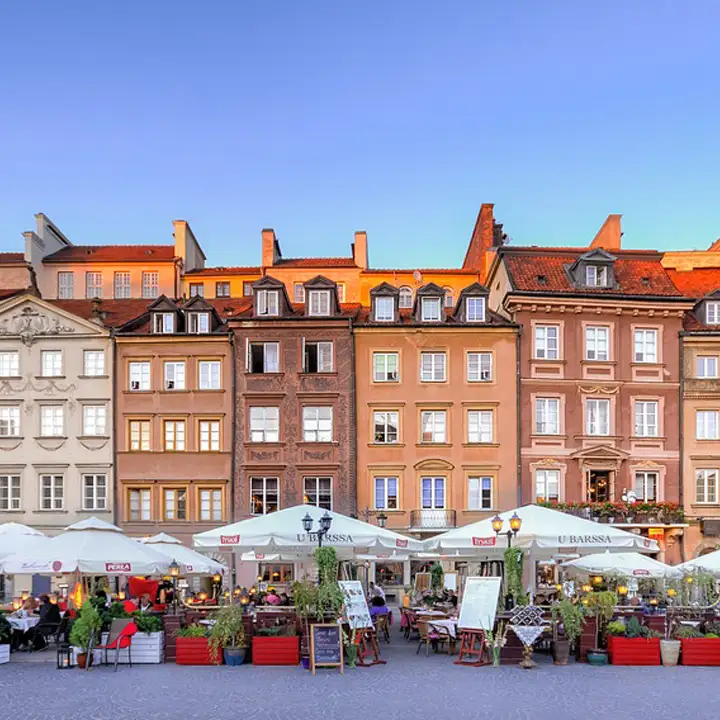
Day 12
Krakow to Warsaw
Day 12
Krakow to Warsaw





9:00 AM
Taxi Transfer to Krakow Rail Station
Most trains depart from Krakow Main Rail Station (Kraków Główny) station, the largest station in the city. Before spending money on a transfer, be sure to check whether your hotel is within easy walking distance. Also consider that public transport is the cheapest and sometimes fastest option - trams drop off directly in front of the station. If staying at a hotel, they can order a reliable taxi. Some private transfers will even help with your bags. Uber is also available for those with the app.

Day 12
Krakow to Warsaw



Day 13
Warsaw
Day 13
Warsaw



9:00 AM - 1:00 PM
Old Town Walking Tour, Guided
On this 2.5-hour walking tour, you will be shown around Warsaw's UNESCO-listed Old Town, including the old market square and the famous Mermaid Monument in the middle of it. You will be taken along the beautifully recreated cobbled streets around the square while your guide recounts the stories of the historic building lining them, as well as the story of their post-WWII reconstruction.

Warsaw Mermaid
Warsaw Mermaid (Warszawska Syrenka) is the official symbol of Warsaw.
Show More

Warsaw's Royal Castle
Tour the impressive Royal Castle for an entertaining crash course in Warsaw and Polish history.
Show More

Warsaw Mermaid
Warsaw Mermaid (Warszawska Syrenka) is the official symbol of Warsaw.
Show More

Warsaw's Royal Castle
Tour the impressive Royal Castle for an entertaining crash course in Warsaw and Polish history.
Show More

Warsaw Mermaid
Warsaw Mermaid (Warszawska Syrenka) is the official symbol of Warsaw.
Show More

Warsaw's Royal Castle
Tour the impressive Royal Castle for an entertaining crash course in Warsaw and Polish history.
Show More
prev
next

Day 13
Warsaw


Warsaw Mermaid
 Highlight of Old Town Walking Tour, Guided
Highlight of Old Town Walking Tour, GuidedWarsaw Mermaid (Warszawska Syrenka) is the official symbol of Warsaw.
On the square, Syrenka appeared in the 19th century. According to the legend, she is the sister of Copenhagen Mermaid.

Warsaw's Royal Castle
 Highlight of Old Town Walking Tour, Guided
Highlight of Old Town Walking Tour, GuidedTour the impressive Royal Castle for an entertaining crash course in Warsaw and Polish history.
Like everything else in central Warsaw, the Royal Castle was heavily damaged during the German bombing campaign that sparked WWII in September 1939 and was then completely and literally reduced to smoldering dust in 1944 in revenge for the failed Warsaw Uprising. What you see today is a carbon copy built in the 1970s when the Communist authorities became desperate to position themselves as 'socialist patriots' following decades of delay in the building schedule. Opened to the public in 1984, the Castle today is filled with period furniture and works of art. Highlights of the castle tour include the Great Apartment and its magnificent Great Assembly Hall, which has been restored to its 18th-century decor of dazzling gilded stucco and golden columns. The neighboring National Hall was conceived as a national pantheon; the six huge canvases (surviving originals) depict pivotal scenes from Polish history. Further on from the National Hall is the lavishly decorated Throne Room. Connected by a short corridor is the King’s Apartment, the highlight of which is the Canaletto Room at the far end. An impressive array of 23 paintings by Bernardo Bellotto, better known in Poland as Canaletto, captures Warsaw's mid-18th-century heyday in great detail. The works were of immense help in reconstructing the city’s historic facades.

Warsaw Mermaid
 Highlight of Old Town Walking Tour, Guided
Highlight of Old Town Walking Tour, GuidedWarsaw Mermaid (Warszawska Syrenka) is the official symbol of Warsaw.
On the square, Syrenka appeared in the 19th century. According to the legend, she is the sister of Copenhagen Mermaid.

Warsaw's Royal Castle
 Highlight of Old Town Walking Tour, Guided
Highlight of Old Town Walking Tour, GuidedTour the impressive Royal Castle for an entertaining crash course in Warsaw and Polish history.
Like everything else in central Warsaw, the Royal Castle was heavily damaged during the German bombing campaign that sparked WWII in September 1939 and was then completely and literally reduced to smoldering dust in 1944 in revenge for the failed Warsaw Uprising. What you see today is a carbon copy built in the 1970s when the Communist authorities became desperate to position themselves as 'socialist patriots' following decades of delay in the building schedule. Opened to the public in 1984, the Castle today is filled with period furniture and works of art. Highlights of the castle tour include the Great Apartment and its magnificent Great Assembly Hall, which has been restored to its 18th-century decor of dazzling gilded stucco and golden columns. The neighboring National Hall was conceived as a national pantheon; the six huge canvases (surviving originals) depict pivotal scenes from Polish history. Further on from the National Hall is the lavishly decorated Throne Room. Connected by a short corridor is the King’s Apartment, the highlight of which is the Canaletto Room at the far end. An impressive array of 23 paintings by Bernardo Bellotto, better known in Poland as Canaletto, captures Warsaw's mid-18th-century heyday in great detail. The works were of immense help in reconstructing the city’s historic facades.

Warsaw Mermaid
 Highlight of Old Town Walking Tour, Guided
Highlight of Old Town Walking Tour, GuidedWarsaw Mermaid (Warszawska Syrenka) is the official symbol of Warsaw.
On the square, Syrenka appeared in the 19th century. According to the legend, she is the sister of Copenhagen Mermaid.

Warsaw's Royal Castle
 Highlight of Old Town Walking Tour, Guided
Highlight of Old Town Walking Tour, GuidedTour the impressive Royal Castle for an entertaining crash course in Warsaw and Polish history.
Like everything else in central Warsaw, the Royal Castle was heavily damaged during the German bombing campaign that sparked WWII in September 1939 and was then completely and literally reduced to smoldering dust in 1944 in revenge for the failed Warsaw Uprising. What you see today is a carbon copy built in the 1970s when the Communist authorities became desperate to position themselves as 'socialist patriots' following decades of delay in the building schedule. Opened to the public in 1984, the Castle today is filled with period furniture and works of art. Highlights of the castle tour include the Great Apartment and its magnificent Great Assembly Hall, which has been restored to its 18th-century decor of dazzling gilded stucco and golden columns. The neighboring National Hall was conceived as a national pantheon; the six huge canvases (surviving originals) depict pivotal scenes from Polish history. Further on from the National Hall is the lavishly decorated Throne Room. Connected by a short corridor is the King’s Apartment, the highlight of which is the Canaletto Room at the far end. An impressive array of 23 paintings by Bernardo Bellotto, better known in Poland as Canaletto, captures Warsaw's mid-18th-century heyday in great detail. The works were of immense help in reconstructing the city’s historic facades.
prev
next


Day 14
Warsaw
Day 14
Warsaw



10:00 AM - 1:00 PM
Communism Tour
On this 4-hour guided tour, you will be intrigued by a visit to Constitution Square, discover the utopian plans of the Ministry of Agriculture, feel the propaganda at the Palace of Culture and Science (PKiN), and learn about the hitherto unknown secrets of the former Central Committee headquarters. Your guide will also take you to the Museum of Life under Communism (“Charm of the PRL” Museum) where you will go back in time to understand the reality of the communist regime. You also will have a chance to watch some propaganda movies and relax for a while in a cozy communist-style café.

Palace of Culture
This neo-Baroque leviathan was a 'gift' from the Soviets to the Polish people, and not one that could be refused.
Show More

Palace of Culture
This neo-Baroque leviathan was a 'gift' from the Soviets to the Polish people, and not one that could be refused.
Show More

Palace of Culture
This neo-Baroque leviathan was a 'gift' from the Soviets to the Polish people, and not one that could be refused.
Show More

Palace of Culture
This neo-Baroque leviathan was a 'gift' from the Soviets to the Polish people, and not one that could be refused.
Show More

Palace of Culture
This neo-Baroque leviathan was a 'gift' from the Soviets to the Polish people, and not one that could be refused.
Show More
prev
next

Day 14
Warsaw

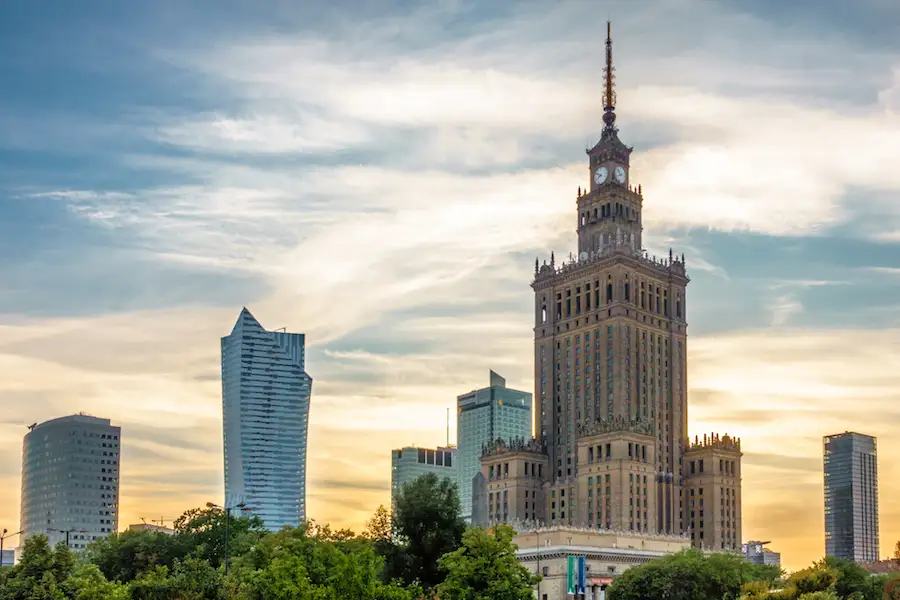
Palace of Culture
 Highlight of Communism Tour
Highlight of Communism TourThis neo-Baroque leviathan was a 'gift' from the Soviets to the Polish people, and not one that could be refused.
Known to the locals as "the Russian cake", the building evokes intense emotions among Varsovians. Some maintain that the best views of Warsaw are from the Palace's top floor - the only viewpoint from which one can't see the building at all - while others are willing to grant it a sinister kind of elegance, especially when compared to the glass skyscrapers that have sprouted up nearby. Whatever your sense of aesthetics, there's no doubting that the Palace and the newer high-rise buildings around it provide an attractive view when lit up in the evening.

Palace of Culture
 Highlight of Communism Tour
Highlight of Communism TourThis neo-Baroque leviathan was a 'gift' from the Soviets to the Polish people, and not one that could be refused.
Known to the locals as "the Russian cake", the building evokes intense emotions among Varsovians. Some maintain that the best views of Warsaw are from the Palace's top floor - the only viewpoint from which one can't see the building at all - while others are willing to grant it a sinister kind of elegance, especially when compared to the glass skyscrapers that have sprouted up nearby. Whatever your sense of aesthetics, there's no doubting that the Palace and the newer high-rise buildings around it provide an attractive view when lit up in the evening.

Palace of Culture
 Highlight of Communism Tour
Highlight of Communism TourThis neo-Baroque leviathan was a 'gift' from the Soviets to the Polish people, and not one that could be refused.
Known to the locals as "the Russian cake", the building evokes intense emotions among Varsovians. Some maintain that the best views of Warsaw are from the Palace's top floor - the only viewpoint from which one can't see the building at all - while others are willing to grant it a sinister kind of elegance, especially when compared to the glass skyscrapers that have sprouted up nearby. Whatever your sense of aesthetics, there's no doubting that the Palace and the newer high-rise buildings around it provide an attractive view when lit up in the evening.

Palace of Culture
 Highlight of Communism Tour
Highlight of Communism TourThis neo-Baroque leviathan was a 'gift' from the Soviets to the Polish people, and not one that could be refused.
Known to the locals as "the Russian cake", the building evokes intense emotions among Varsovians. Some maintain that the best views of Warsaw are from the Palace's top floor - the only viewpoint from which one can't see the building at all - while others are willing to grant it a sinister kind of elegance, especially when compared to the glass skyscrapers that have sprouted up nearby. Whatever your sense of aesthetics, there's no doubting that the Palace and the newer high-rise buildings around it provide an attractive view when lit up in the evening.

Palace of Culture
 Highlight of Communism Tour
Highlight of Communism TourThis neo-Baroque leviathan was a 'gift' from the Soviets to the Polish people, and not one that could be refused.
Known to the locals as "the Russian cake", the building evokes intense emotions among Varsovians. Some maintain that the best views of Warsaw are from the Palace's top floor - the only viewpoint from which one can't see the building at all - while others are willing to grant it a sinister kind of elegance, especially when compared to the glass skyscrapers that have sprouted up nearby. Whatever your sense of aesthetics, there's no doubting that the Palace and the newer high-rise buildings around it provide an attractive view when lit up in the evening.
prev
next


Day 15
Depart Warsaw
Day 15
Depart Warsaw

To Be Determined
Transfer to Airport
You will likely depart from Warsaw Chopin Airport, although if flying RyanAir or another budget airline you may depart from Warsaw Modlin Airport. The most affordable and sometimes fastest way to reach Warsaw Chopin airport is by train. The S2 and RL trains depart from Warszawa Śródmieście station, which is co-located with Warsaw Central Station. It takes less than 30 minutes to reach the airport. Your hotel can also arrange a reliable taxi or if you have the app, Uber is also a good option. You can also arrange a private transfer for the maximum convenience. If you are picked up about two hours and forty-five minutes before your departure time, you should arrive at the airport with about two hours to spare, depending on traffic. If you are leaving during rush hour, you may want to budget an extra fifteen to thirty minutes.

Day 15
Depart Warsaw


What's Included In Central European Odyssey Trip

Pre-Paid Tours and Activities:
- Best of Budapest: Half-Day Walking Tour of Highlights & Hidden Finds
- Guided Walk through Vienna's Inner City
- Prague Castle & Royal Route Guided Walk
- Walking Tour of Krakow's Historic Center
- Half-Day Guided Walking Tour of Old Town
- Communism Tour in Warsaw in a Retro Van

Pre-Paid Transportation:
- 2nd Class Train Tickets from Budapest to Vienna
- 2nd Class Train Tickets from Vienna to Prague
- 2nd Class Train Tickets from Krakow to Warsaw
- Train Tickets from Prague to Krakow
- Public Transport Tickets for Vienna
- Private Transfer from the Budapest Airport
- Private Transfer from Krakow Rail Station to Your Hotel

Accommodation:
- 2 nights at a hotel of your choice in Budapest
- 3 nights at a hotel of your choice in Vienna
- 3 nights at a hotel of your choice in Prague
- 2 nights at a hotel of your choice in Krakow
- 3 nights at a hotel of your choice in Warsaw

Go Real Travel Mobile App:
- Itinerary Plan & Reservations Info
- Points of Interest
- Detailed Travel Information
- Maps & Directions
Other Trips You May Like

15 Days
From$2750USD
Prague, Vienna, and Budapest, 15 Days of Must See Sights & Local Scenes

Czech Republic, Austria, Hungary

8 Days
From$1425USD
Enchanting Central Europe: 8-Days in Prague, Vienna & Budapest

Czech Republic, Austria, Hungary

12 Days
From$2675USD
Jewish Heritage and Scenic Rivers: A Journey through Prague, Vienna, and Budapest

Hungary, Austria, Czech Republic

12 Days
From$2200USD
A 12-Day Prague, Vienna, Budapest, and Bratislava Itinerary

Czech Republic, Austria, Slovakia, Hungary

14 Days
From$2349USD
Central Europe Heritage Tour: Warsaw, Krakow, Prague & Budapest

Poland, Czech Republic, Hungary

12 Days
From$2350USD

14 Days
From$2875USD
2-Week Journey Through Central & Eastern Europe: History

Germany, Czech Republic, Austria, Hungary, Poland

14 Days
From$2350USD
Imperial Elegance: Prague, Vienna and Budapest Itinerary 14 Days

Czech Republic, Austria, Hungary

7 Days
From$1695USD

15 Days
From$2750USD
Prague, Vienna, and Budapest, 15 Days of Must See Sights & Local Scenes

Czech Republic, Austria, Hungary

8 Days
From$1425USD
Enchanting Central Europe: 8-Days in Prague, Vienna & Budapest

Czech Republic, Austria, Hungary

12 Days
From$2675USD
Jewish Heritage and Scenic Rivers: A Journey through Prague, Vienna, and Budapest

Hungary, Austria, Czech Republic

12 Days
From$2200USD
A 12-Day Prague, Vienna, Budapest, and Bratislava Itinerary

Czech Republic, Austria, Slovakia, Hungary

14 Days
From$2349USD
Central Europe Heritage Tour: Warsaw, Krakow, Prague & Budapest

Poland, Czech Republic, Hungary

12 Days
From$2350USD

14 Days
From$2875USD
2-Week Journey Through Central & Eastern Europe: History

Germany, Czech Republic, Austria, Hungary, Poland

14 Days
From$2350USD
Imperial Elegance: Prague, Vienna and Budapest Itinerary 14 Days

Czech Republic, Austria, Hungary

7 Days
From$1695USD
prev
next
Featured Blogs
prev
next
Our Customers Say It Best
Marianne Strydom, Paarl, South Africa
I just wanted to thank you for organizing an amazing trip for me – I packed in so much in such a short period of time and everything was just perfect. The way you do things makes it possible to really get to know the destination, which for me as a travel agent could not have been better. 

Otto Chuy, Los Angeles, California
I am still surprised how everything worked as planned, without a hitch. All instructions in your itinerary were precise and correct. Your suggestions and comments in each of the locations we went to were very helpful. All your guides, without exception, were wonderful and exactly on time. 

Malini Dutta, Boston, Massachusetts
We can't thank you enough for the detailed plans, maps, and suggestions. It really felt that someone was holding our hands and showing us around. We had all the excitement of discovering foreign lands, with none of the problems that can happen while negotiating unfamiliar places. In fact, all the cities felt like home within a few hours of arriving and exploring. 

Bev and Mark Frankel, Williamsburg, Virginia
We could not be more pleased with Go Real Travel! You took the guess work out of things like public transport but still managed to allow us the freedom to tour as we wanted. Our guides were exceptional and every time I saw a Viking Cruise tour of 25 people, I realized the quality experience we were getting with Go Real. 

Marianne Strydom, Paarl, South Africa
I just wanted to thank you for organizing an amazing trip for me – I packed in so much in such a short period of time and everything was just perfect. The way you do things makes it possible to really get to know the destination, which for me as a travel agent could not have been better. 

Otto Chuy, Los Angeles, California
I am still surprised how everything worked as planned, without a hitch. All instructions in your itinerary were precise and correct. Your suggestions and comments in each of the locations we went to were very helpful. All your guides, without exception, were wonderful and exactly on time. 

Malini Dutta, Boston, Massachusetts
We can't thank you enough for the detailed plans, maps, and suggestions. It really felt that someone was holding our hands and showing us around. We had all the excitement of discovering foreign lands, with none of the problems that can happen while negotiating unfamiliar places. In fact, all the cities felt like home within a few hours of arriving and exploring. 

Bev and Mark Frankel, Williamsburg, Virginia
We could not be more pleased with Go Real Travel! You took the guess work out of things like public transport but still managed to allow us the freedom to tour as we wanted. Our guides were exceptional and every time I saw a Viking Cruise tour of 25 people, I realized the quality experience we were getting with Go Real. 



Explore cities in more detail
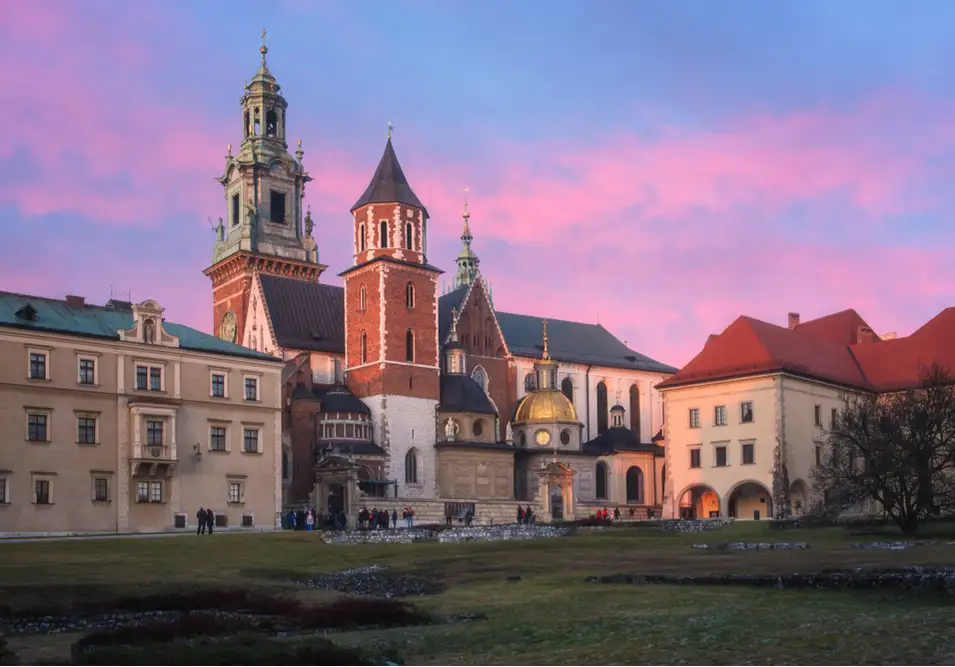
Krakow
Krakow is a city in the south of Poland and the country’s former royal capital. Thought to have been inhabited for tens of thousands of years, the history here seems to sit comfortably alongside the vibrant, young city that is Krakow today. The main market square at Krakow’s center is overlooked by St Mary’s Basilica, a perfect example of Polish Gothic architecture and a UNESCO World Heritage Site. The square itself is usually filled with life, as the pubs and restaurants around the edges spill out onto the sidewalks. Winter is cold here, but that’s just a perfect excuse to slip inside a cozy, well-heated pub and sip hot mulled wine over a hearty Polish dinner. With all of Krakow’s heady charm, it can be easy to forget the all-too-recent atrocities that occurred in this region. A short trip to the Auschwitz-Birkenau concentration camp nearby, where the Nazis committed their genocide, provides a sober but important reminder of that past. A hard past exists alongside a happy and electric present in Krakow, a city that has endured centuries of trials and emerged looking better than ever.

Learn About Krakow
Build Krakow Trip
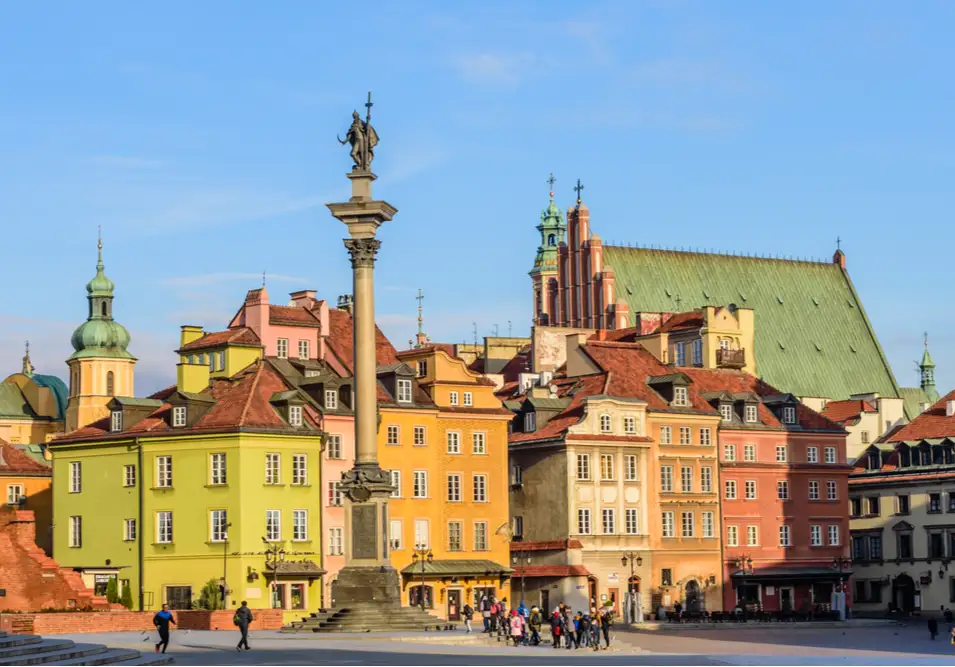
Warsaw
Warsaw is a place that seems almost indestructible. Nearly bombed out of existence in World War II, the city rebuilt itself out of the rubble, and today it’s a shining example of a thriving European capital with a lot to offer. History forms a big part of Warsaw’s allure. Occupied by the Nazis, and losing much of its Jewish population to the Holocaust, Warsaw has several museums dedicated to remembering its dark past. The Warsaw Uprising Museum, POLIN Museum of the History of Polish Jews, and National Museum are among the most prominent. Although its past has been troubled, Warsaw’s present is anything but. The city contains countless opportunities for fun, with a blossoming nightlife scene and a vibrant cafe culture. After a day of wandering through the old streets and charming squares, there are plenty of places to enjoy a meal, from high-end restaurants to affordable milk bars. Warsaw is a place for reflection and remembrance, but also a place that looks firmly towards the future, a future that for this city— appears increasingly bright.

Learn About Warsaw
Build Warsaw Trip
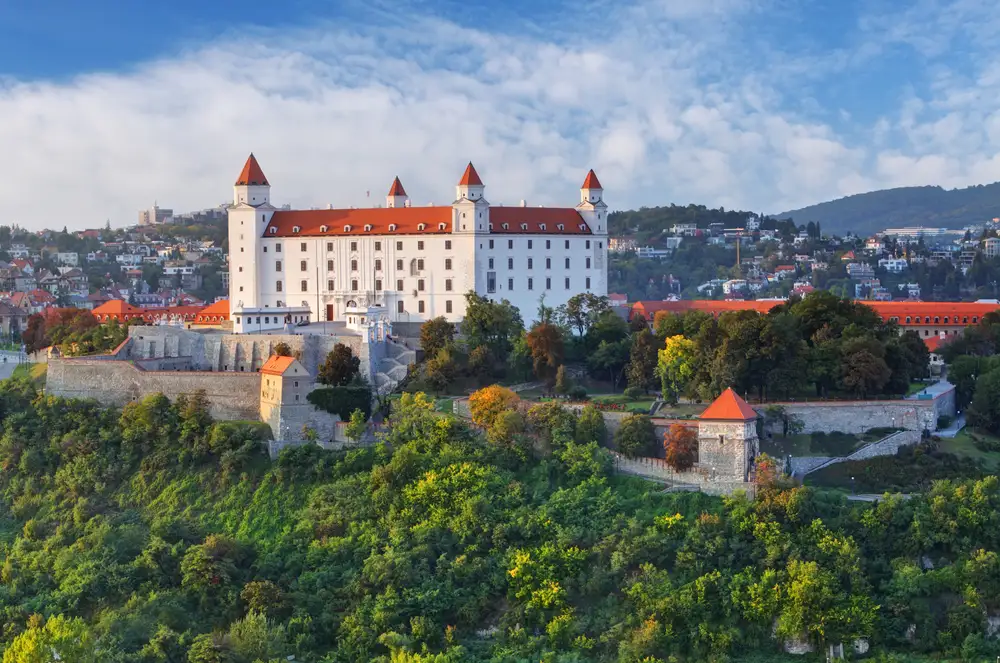
Bratislava
Bratislava is one of the most up-and-coming cities in central Europe. After years in the shadows of the Soviet bloc, and often drowned out by Prague, Bratislava has finally broken out. The Bratislavan region is now one of the richest per capita in the EU. This economic upswing has infused Bratislava with a newfound zeal. Trendy cafes and cool shopping centers are popping up everywhere, and the city’s already happening nightlife scene is only set to get better. Still less crowded than its central European neighbors Prague, Vienna, and Budapest, but just as intriguing, there’s really never been a better time for a visit to Bratislava. Ruled over by the Hungarians, Austrians, and most recently the Soviets, Bratislava is a city of strange contrasts. As soon as you arrive in Bratislava, you’ll see the pastel-hued churches, baroque houses, and the cobbled Old Town Square brush shoulders with modern brutalist buildings, retrofuturistic towers, and the clunky communist built UFO bridge. The city’s oldest building, its castle, is set atop the western edge of the Little Carpathian Hills like a trophy, the city’s hard-won main icon. For the first time in nearly a millennium, Bratislava has now seized control of its own destiny, and it shows.

Learn About Bratislava
Build Bratislava Trip
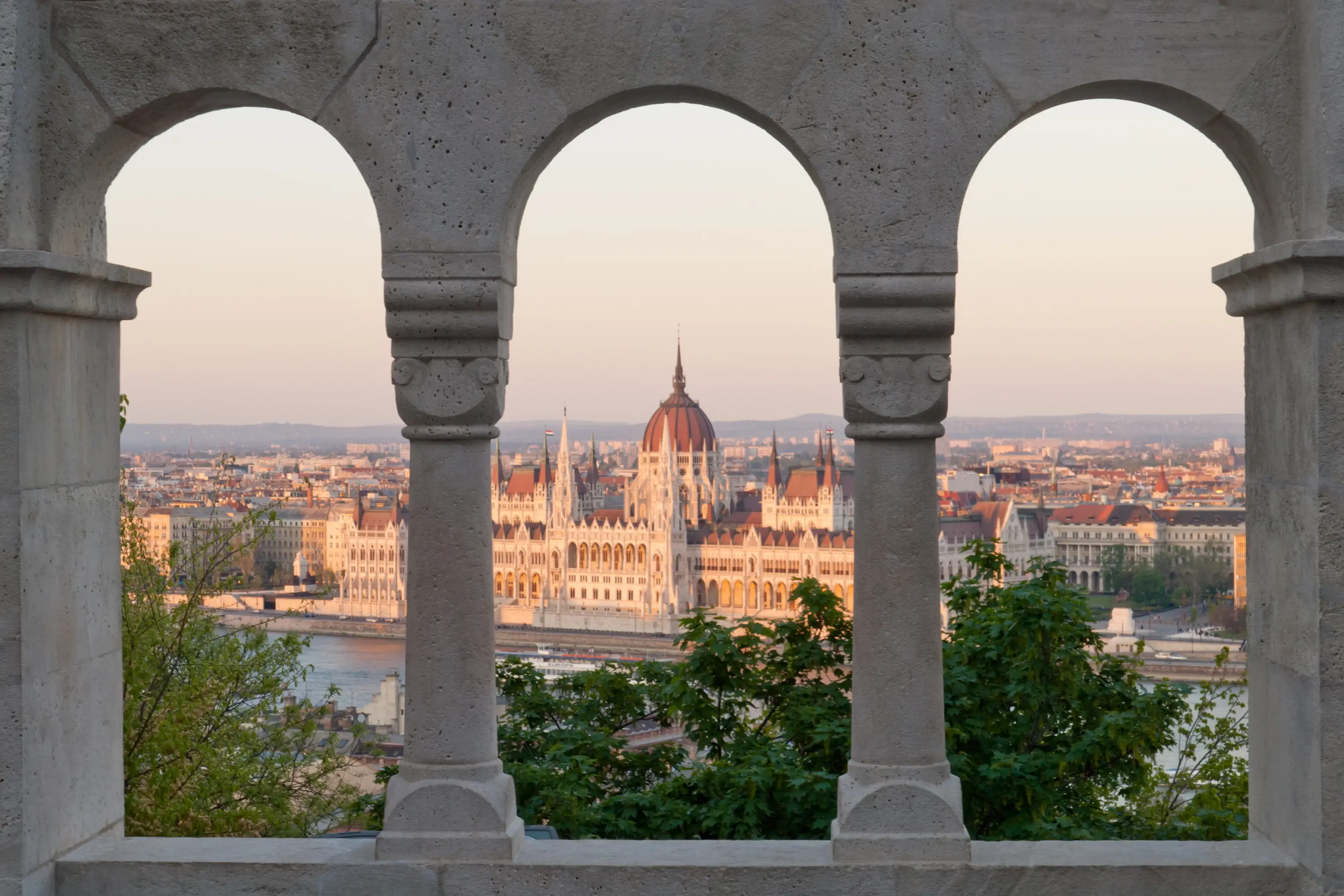
Budapest
Situated at the heart of Europe, Budapest is the capital of Hungary, appropriately named 'The Pearl of the Danube,' for its fixating and almost haunting beauty. Formerly two separate cities, Buda and Pest were forged into one by time, occupation, and the eight bridges that anchor them together today. From the Romans to the Communists, each occupier left its flavor profile in Budapest, evident in the famous spicy Hungarian stew known as 'goulash.' Budapest is a melting pot of history, culture, and taste, from the magnificent Baroque and neo-Gothic architecture to the Turkish thermal baths. After a long day of sightseeing, treat yourself to a glass of Tokaj, what King Louis XIV of France referred to as the "Wine of Kings, King of Wines". Budapest has a flavor to satisfy any taste.

Learn About Budapest
Build Budapest Trip
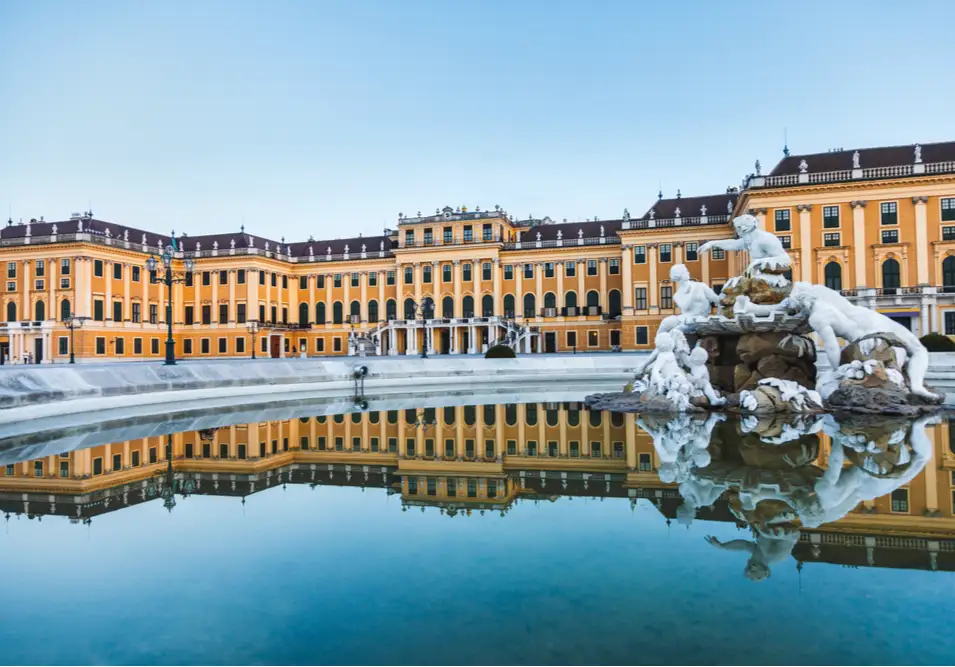
Vienna
Artistic and musical, historical and elegant, Vienna is the definition of class. The seat of the Habsburg monarchy for over six centuries, it's no wonder this city is still fit for royalty. Baroque buildings and imperial palaces dominate the cityscape, while locals stride gracefully through the streets, likely on their way to a classical music concert or art exhibition. Visitors from all over the world flock to Schonbrunn Palace, historical museums, and local eateries for authentic Viennese schnitzel. Vienna is also home to world-class wining and dining. Famous dishes include Wiener schnitzel, Tafelspitz (prime boiled beef), and apfelstrudel (apple strudel), all of which pair well with a glass of fine Austrian wine. No matter how long you spend in Vienna, you'll leave with a new appreciation for the finer things in life.

Learn About Vienna
Build Vienna Trip
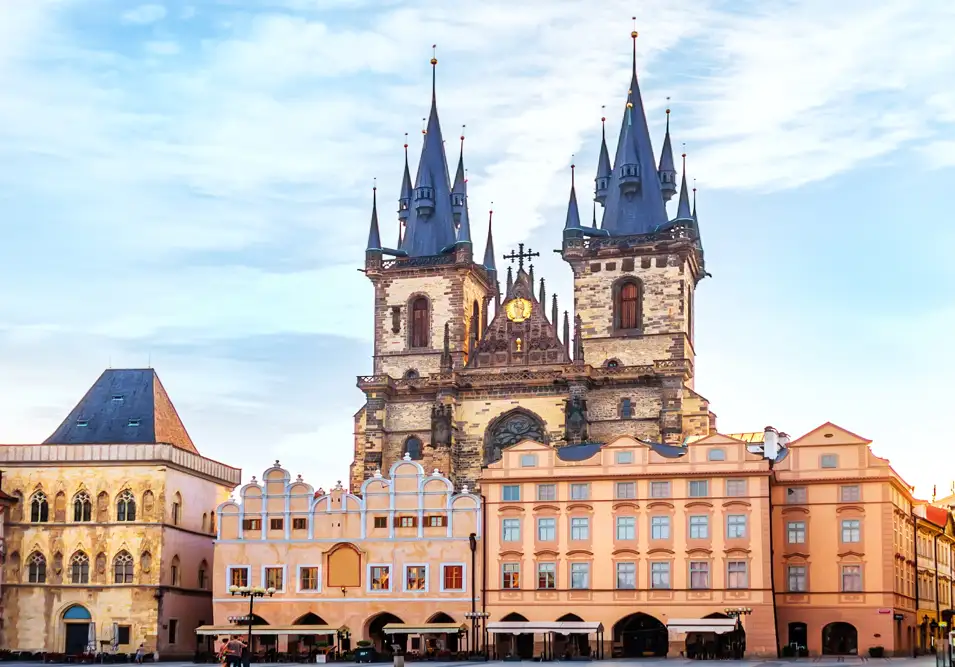
Prague
The city of Prague is indisputably the gem of Central Europe. Full of history, culture, and classic Czech pubs around every corner, Prague is teeming with nooks and crannies just waiting to be discovered. The narrow cobblestone streets and warm red rooftops give the city a homey feel, while the well-preserved medieval architecture transports you back in time. Walking across the Charles Bridge with the view of the Prague Castle will make you feel like you’re living in a fairytale, and you might as well be. As an up-and-coming destination, Prague is a perfect mix of classic and modern. New trendy cafes and bistros are always popping up, and you can always find a group of lively locals chowing down on goulash and quaffing pivo (the best beer in Europe!) at traditional Czech restaurants across the city. The clash of modernity and tradition, preservation and innovation, gives this city a mysterious air that you won’t soon forget.

Learn About Prague
Build Prague Trip

Krakow
Krakow is a city in the south of Poland and the country’s former royal capital. Thought to have been inhabited for tens of thousands of years, the history here seems to sit comfortably alongside the vibrant, young city that is Krakow today. The main market square at Krakow’s center is overlooked by St Mary’s Basilica, a perfect example of Polish Gothic architecture and a UNESCO World Heritage Site. The square itself is usually filled with life, as the pubs and restaurants around the edges spill out onto the sidewalks. Winter is cold here, but that’s just a perfect excuse to slip inside a cozy, well-heated pub and sip hot mulled wine over a hearty Polish dinner. With all of Krakow’s heady charm, it can be easy to forget the all-too-recent atrocities that occurred in this region. A short trip to the Auschwitz-Birkenau concentration camp nearby, where the Nazis committed their genocide, provides a sober but important reminder of that past. A hard past exists alongside a happy and electric present in Krakow, a city that has endured centuries of trials and emerged looking better than ever.

Learn About Krakow
Build Krakow Trip

Warsaw
Warsaw is a place that seems almost indestructible. Nearly bombed out of existence in World War II, the city rebuilt itself out of the rubble, and today it’s a shining example of a thriving European capital with a lot to offer. History forms a big part of Warsaw’s allure. Occupied by the Nazis, and losing much of its Jewish population to the Holocaust, Warsaw has several museums dedicated to remembering its dark past. The Warsaw Uprising Museum, POLIN Museum of the History of Polish Jews, and National Museum are among the most prominent. Although its past has been troubled, Warsaw’s present is anything but. The city contains countless opportunities for fun, with a blossoming nightlife scene and a vibrant cafe culture. After a day of wandering through the old streets and charming squares, there are plenty of places to enjoy a meal, from high-end restaurants to affordable milk bars. Warsaw is a place for reflection and remembrance, but also a place that looks firmly towards the future, a future that for this city— appears increasingly bright.

Learn About Warsaw
Build Warsaw Trip

Bratislava
Bratislava is one of the most up-and-coming cities in central Europe. After years in the shadows of the Soviet bloc, and often drowned out by Prague, Bratislava has finally broken out. The Bratislavan region is now one of the richest per capita in the EU. This economic upswing has infused Bratislava with a newfound zeal. Trendy cafes and cool shopping centers are popping up everywhere, and the city’s already happening nightlife scene is only set to get better. Still less crowded than its central European neighbors Prague, Vienna, and Budapest, but just as intriguing, there’s really never been a better time for a visit to Bratislava. Ruled over by the Hungarians, Austrians, and most recently the Soviets, Bratislava is a city of strange contrasts. As soon as you arrive in Bratislava, you’ll see the pastel-hued churches, baroque houses, and the cobbled Old Town Square brush shoulders with modern brutalist buildings, retrofuturistic towers, and the clunky communist built UFO bridge. The city’s oldest building, its castle, is set atop the western edge of the Little Carpathian Hills like a trophy, the city’s hard-won main icon. For the first time in nearly a millennium, Bratislava has now seized control of its own destiny, and it shows.

Learn About Bratislava
Build Bratislava Trip

Budapest
Situated at the heart of Europe, Budapest is the capital of Hungary, appropriately named 'The Pearl of the Danube,' for its fixating and almost haunting beauty. Formerly two separate cities, Buda and Pest were forged into one by time, occupation, and the eight bridges that anchor them together today. From the Romans to the Communists, each occupier left its flavor profile in Budapest, evident in the famous spicy Hungarian stew known as 'goulash.' Budapest is a melting pot of history, culture, and taste, from the magnificent Baroque and neo-Gothic architecture to the Turkish thermal baths. After a long day of sightseeing, treat yourself to a glass of Tokaj, what King Louis XIV of France referred to as the "Wine of Kings, King of Wines". Budapest has a flavor to satisfy any taste.

Learn About Budapest
Build Budapest Trip

Vienna
Artistic and musical, historical and elegant, Vienna is the definition of class. The seat of the Habsburg monarchy for over six centuries, it's no wonder this city is still fit for royalty. Baroque buildings and imperial palaces dominate the cityscape, while locals stride gracefully through the streets, likely on their way to a classical music concert or art exhibition. Visitors from all over the world flock to Schonbrunn Palace, historical museums, and local eateries for authentic Viennese schnitzel. Vienna is also home to world-class wining and dining. Famous dishes include Wiener schnitzel, Tafelspitz (prime boiled beef), and apfelstrudel (apple strudel), all of which pair well with a glass of fine Austrian wine. No matter how long you spend in Vienna, you'll leave with a new appreciation for the finer things in life.

Learn About Vienna
Build Vienna Trip

Prague
The city of Prague is indisputably the gem of Central Europe. Full of history, culture, and classic Czech pubs around every corner, Prague is teeming with nooks and crannies just waiting to be discovered. The narrow cobblestone streets and warm red rooftops give the city a homey feel, while the well-preserved medieval architecture transports you back in time. Walking across the Charles Bridge with the view of the Prague Castle will make you feel like you’re living in a fairytale, and you might as well be. As an up-and-coming destination, Prague is a perfect mix of classic and modern. New trendy cafes and bistros are always popping up, and you can always find a group of lively locals chowing down on goulash and quaffing pivo (the best beer in Europe!) at traditional Czech restaurants across the city. The clash of modernity and tradition, preservation and innovation, gives this city a mysterious air that you won’t soon forget.

Learn About Prague
Build Prague Trip
prev
next


 Map of Your Itinerary Route
Map of Your Itinerary Route
Zoom In to the cities to see your itinerary in more detail


 4.8
4.8 






